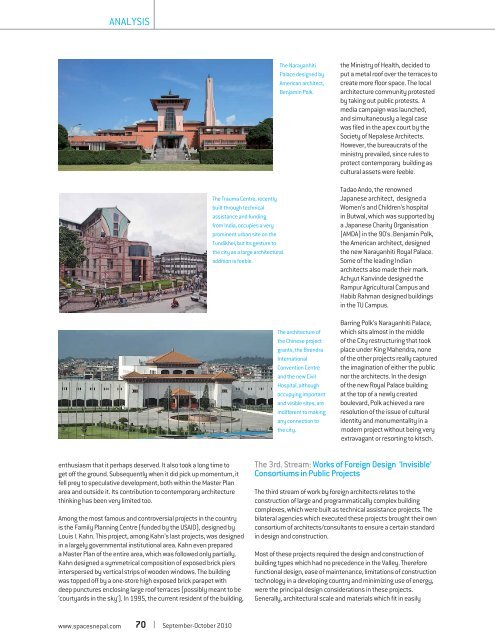5. September - October 2010
Create successful ePaper yourself
Turn your PDF publications into a flip-book with our unique Google optimized e-Paper software.
ANALYSIS<br />
The Trauma Centre, recently<br />
built through technical<br />
assistance and funding<br />
from India, occupies a very<br />
prominent urban site on the<br />
Tundikhel, but its gesture to<br />
the city as a large architectural<br />
addition is feeble.<br />
The Narayanhiti<br />
Palace designed by<br />
American architect,<br />
Benjamin Polk.<br />
The architecture of<br />
the Chinese project<br />
grants, the Birendra<br />
International<br />
Convention Centre<br />
and the new Civil<br />
Hospital, although<br />
occupying important<br />
and visible sites, are<br />
indifferent to making<br />
any connection to<br />
the city.<br />
the Ministry of Health, decided to<br />
put a metal roof over the terraces to<br />
create more floor space. The local<br />
architecture community protested<br />
by taking out public protests. A<br />
media campaign was launched,<br />
and simultaneously a legal case<br />
was filed in the apex court by the<br />
Society of Nepalese Architects.<br />
However, the bureaucrats of the<br />
ministry prevailed, since rules to<br />
protect contemporary building as<br />
cultural assets were feeble.<br />
Tadao Ando, the renowned<br />
Japanese architect, designed a<br />
Women’s and Children’s hospital<br />
in Butwal, which was supported by<br />
a Japanese Charity Organisation<br />
(AMDA) in the 90's. Benjamin Polk,<br />
the American architect, designed<br />
the new Narayanhiti Royal Palace.<br />
Some of the leading Indian<br />
architects also made their mark.<br />
Achyut Kanvinde designed the<br />
Rampur Agricultural Campus and<br />
Habib Rahman designed buildings<br />
in the TU Campus.<br />
Barring Polk’s Narayanhiti Palace,<br />
which sits almost in the middle<br />
of the City restructuring that took<br />
place under King Mahendra, none<br />
of the other projects really captured<br />
the imagination of either the public<br />
nor the architects. In the design<br />
of the new Royal Palace building<br />
at the top of a newly created<br />
boulevard, Polk achieved a rare<br />
resolution of the issue of cultural<br />
identity and monumentality in a<br />
modern project without being very<br />
extravagant or resorting to kitsch.<br />
enthusiasm that it perhaps deserved. It also took a long time to<br />
get off the ground. Subsequently when it did pick up momentum, it<br />
fell prey to speculative development, both within the Master Plan<br />
area and outside it. Its contribution to contemporary architecture<br />
thinking has been very limited too.<br />
Among the most famous and controversial projects in the country<br />
is the Family Planning Centre (funded by the USAID), designed by<br />
Louis I. Kahn. This project, among Kahn’s last projects, was designed<br />
in a largely governmental institutional area. Kahn even prepared<br />
a Master Plan of the entire area, which was followed only partially.<br />
Kahn designed a symmetrical composition of exposed brick piers<br />
interspersed by vertical strips of wooden windows. The building<br />
was topped off by a one-store high exposed brick parapet with<br />
deep punctures enclosing large roof terraces (possibly meant to be<br />
‘courtyards in the sky’). In 1995, the current resident of the building,<br />
The 3rd. Stream: Works of Foreign Design ‘Invisible’<br />
Consortiums in Public Projects<br />
The third stream of work by foreign architects relates to the<br />
construction of large and programmatically complex building<br />
complexes, which were built as technical assistance projects. The<br />
bilateral agencies which executed these projects brought their own<br />
consortium of architects/consultants to ensure a certain standard<br />
in design and construction.<br />
Most of these projects required the design and construction of<br />
building types which had no precedence in the Valley. Therefore<br />
functional design, ease of maintenance, limitations of construction<br />
technology in a developing country and minimizing use of energy,<br />
were the principal design considerations in these projects.<br />
Generally, architectural scale and materials which fit in easily<br />
www.spacesnepal.com 70<br />
<strong>September</strong>-<strong>October</strong> <strong>2010</strong>

















